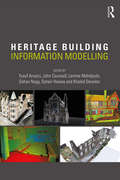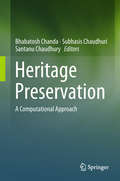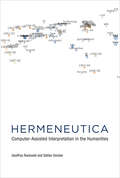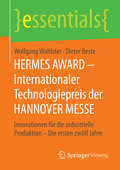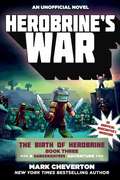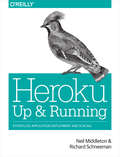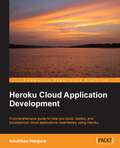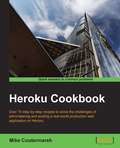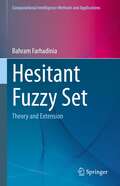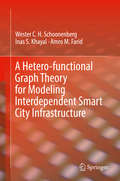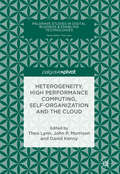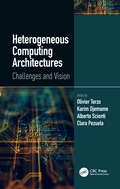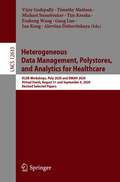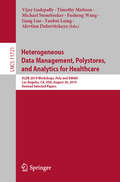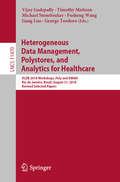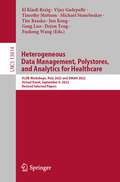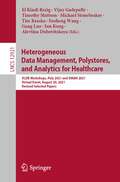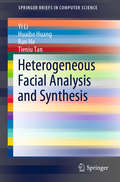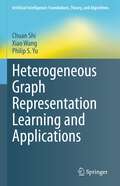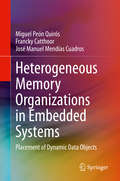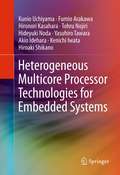- Table View
- List View
Los herederos de Fujimori: El legado de El último dictador
by José Alejandro GodoyEl periodista José Alejandro Godoy regresa con un nuevo libro despúes de El último dictador. En Los herederos de Fujimori, nos presenta una exhaustiva investigación bibliográfica y periodística sobre la vida política de sus dos descendientes y otros personajes de la política peruana. En el contundente El último dictador, José Alejandro Godoy elaboró un relato pormenorizado de la larga década de autoritarismo, violencia y corrupción que tuvo como protagonista a Alberto Fujimori. En esta ocasión, la tarea emprendida en Los herederos de Fujimori es todavía más ambiciosa: abarcar más de veinte años de historia política que, inevitablemente, han estado marcados a sangre y fuego por el linaje de nuestro último dictador. Mediante un exhaustivo trabajo de investigación bibliográfica y periodística, Godoy recorre un vertiginoso período de la historia peruana en el que la herencia fujimorista no solo se ha manifestado en la omnipresencia de dos de sus descendientes en la vida política del país, sino también en los modales (poco) democráticos, las fórmulas populistas y la propensión a los escándalos —de toda índole— que caracterizaron los mandatos de prácticamente todos sus sucesores en Palacio de Gobierno. Alejandro Toledo, Alan García, Ollanta Humala, Martín Vizcarra, Pedro Pablo Kuczynski y Keiko Fujimori son algunos de los personajes recurrentes en esta historia, pero no los únicos. Entre desastres naturales (y de los otros), presidencias truncas, sobornos millonarios, asilos, indultos y carcelerías de alto vuelo, queda claro que el Perú es un territorio signado por la incombustible flama de un tambaleante quehacer político. Este libro recupera la memoria de los últimos años, y revela un país que aún lucha por encontrar un mejor destino.
Heritage and the Sea: Volume 2: Maritime History and Archaeology of the Global Iberian World (15th–18th centuries)
by Ana Crespo Solana Filipe Castro Nigel NaylingThis two-volume set highlights the importance of Iberian shipbuilding in the centuries of the so-called first globalization (15th to 18th), in confluence with an unprecedented extension of ocean navigation and seafaring and a greater demand for natural resources (especially timber), mostly oak (Quercus spp.) and Pine (Pinus spp.). The chapters are framed in a multidisciplinary and interdisciplinary line of research that integrates history, Geographic Information Sciences, underwater archaeology, dendrochronology and wood provenance techniques. This line of research was developed during the ForSEAdiscovery project, which had a great impact in the academic and scientific world and brought together experts from Europe and America. The volumes deliver a state-of-the-art review of the latest lines of research related to Iberian maritime history and archaeology and their developing interdisciplinary interaction with dendroarchaeology. This synthesis combines an analysis of historical sources, the systematic study of wreck-remains and material culture related to Iberian seafaring from the 15th to the 18th centuries, and the application of earth sciences, including dendrochronology. The set can be used as a manual or work guide for experts and students, and will also be an interesting read for non-experts interested in the subject. Volume 2 focuses on approaches to the study of shipwrecks including a synthesis of dendro-archaeological results, current interdisciplinary case studies and the specialist study of artillery and anchors.
Heritage and the Sea: Volume 1: Maritime History and Archaeology of the Global Iberian World (15th-18th centuries)
by Ana Crespo Solana Filipe Castro Nigel NaylingThis two-volume set highlights the importance of Iberian shipbuilding in the centuries of the so-called first globalization (15th to 18th), in confluence with an unprecedented extension of ocean navigation and seafaring and a greater demand for natural resources (especially timber), mostly oak (Quercus spp.) and Pine (Pinus spp.). The chapters are framed in a multidisciplinary and interdisciplinary line of research that integrates history, Geographic Information Sciences, underwater archaeology, dendrochronology and wood provenance techniques. This line of research was developed during the ForSEAdiscovery project, which had a great impact in the academic and scientific world and brought together experts from Europe and America. The volumes deliver a state-of-the-art review of the latest lines of research related to Iberian maritime history and archaeology and their developing interdisciplinary interaction with dendroarchaeology. This synthesis combines an analysis of historical sources, the systematic study of wreck-remains and material culture related to Iberian seafaring from the 15th to the 18th centuries, and the application of earth sciences, including dendrochronology. The set can be used as a manual or work guide for experts and students, and will also be an interesting read for non-experts interested in the subject. Volume 1 focuses on the history and archaeology of seafaring and shipbuilding in the Iberian early modern world, complemented by case studies on timber trade and supply for shipbuilding, analysis of shipbuilding treatises, and the application of Geographic Information Systems and Databases (GIS) to the study of shipwrecks.
Heritage Building Information Modelling
by Yusuf Arayici John Counsell Lamine Mahdjoubi Gehan Ahmed Nagy Soheir Hawas Khaled DweidarBuilding Information Modelling (BIM) is being debated, tested and implemented wherever you look across the built environment sector. This book is about Heritage Building Information Modelling (HBIM), which necessarily differs from the commonplace applications of BIM to new construction. Where BIM is being used, the focus is still very much on design and construction. However, its use as an operational and management tool for existing buildings, particularly heritage buildings, is lagging behind. The first of its kind, this book aims to clearly define the scope for HBIM and present cutting-edge research findings alongside international case studies, before outlining challenges for the future of HBIM research and practice. After an extensive introduction to HBIM, the core themes of the book are arranged into four parts: Restoration philosophies in practice Data capture and visualisation for maintenance and repair Building performance Stakeholder engagement This book will be a key reference for built environment practitioners, researchers, academics and students engaged in BIM, HBIM, building energy modelling, building surveying, facilities management and heritage conservation more widely.
Heritage Preservation: A Computational Approach
by Bhabatosh Chanda Subhasis Chaudhuri Santanu ChaudhuryThis book presents a unique guide to heritage preservation problems and the corresponding state-of-the-art digital techniques to achieve their plausible solutions. It covers various methods, ranging from data acquisition and digital imaging to computational methods for reconstructing the original (pre-damaged) appearance of heritage artefacts.The case studies presented here are mostly drawn from India’s tangible and non-tangible heritage, which is very rich and multi-dimensional. The contributing authors have been working in their respective fields for years and present their methods so lucidly that they can be easily reproduced and implemented by general practitioners of heritage curation. The preservation methods, reconstruction methods, and corresponding results are all illustrated with a wealth of colour figures and images.The book consists of sixteen chapters that are divided into five broad sections, namely (i) Digital System for Heritage Preservation, (ii) Signal and Image Processing, (iii) Audio and Video Processing, (iv) Image and Video Database, and (v) Architectural Modelling and Visualization. The first section presents various state-of-the-art tools and technologies for data acquisition including an interactive graphical user interface (GUI) annotation tool and a specialized imaging system for generating the realistic visual forms of the artefacts. Numerous useful methods and algorithms for processing vocal, visual and tactile signals related to heritage preservation are presented in the second and third sections. In turn, the fourth section provides two important image and video databases, catering to members of the computer vision community with an interest in the domain of digital heritage. Finally, examples of reconstructing ruined monuments on the basis of historic documents are presented in the fifth section. In essence, this book offers a pragmatic appraisal of the uses of digital technology in the various aspects of preservation of tangible and intangible heritages.
Hermeneutica: Computer-Assisted Interpretation in the Humanities
by Geoffrey Rockwell Stefan SinclairAn introduction to text analysis using computer-assisted interpretive practices, accompanied by example essays that illustrate the use of these computational tools.The image of the scholar as a solitary thinker dates back at least to Descartes' Discourse on Method. But scholarly practices in the humanities are changing as older forms of communal inquiry are combined with modern research methods enabled by the Internet, accessible computing, data availability, and new media. Hermeneutica introduces text analysis using computer-assisted interpretive practices. It offers theoretical chapters about text analysis, presents a set of analytical tools (called Voyant) that instantiate the theory, and provides example essays that illustrate the use of these tools. Voyant allows users to integrate interpretation into texts by creating hermeneutica—small embeddable “toys” that can be woven into essays published online or into such online writing environments as blogs or wikis. The book's companion website, Hermeneuti.ca, offers the example essays with both text and embedded interactive panels. The panels show results and allow readers to experiment with the toys themselves.The use of these analytical tools results in a hybrid essay: an interpretive work embedded with hermeneutical toys that can be explored for technique. The hermeneutica draw on and develop such common interactive analytics as word clouds and complex data journalism interactives. Embedded in scholarly texts, they create a more engaging argument. Moving between tool and text becomes another thread in a dynamic dialogue.
HERMES AWARD - Internationaler Technologiepreis der HANNOVER MESSE: Innovationen für die industrielle Produktion – Die ersten zwölf Jahre (essentials)
by Wolfgang Wahlster Dieter BesteDasessential stellt die Preistr#65533;ger undNominierten des Hermes Awards im Zusammenhang mit dem Paradigmenwechsel derindustriellen Fertigung im Internetzeitalter vor. Zun#65533;chst erl#65533;utern dreiExperten das Konzept der Industrie 4. 0. Im Anschluss werden Gewinner undnominierte Firmen des Hermes Awards 2015 sowie die Preistr#65533;ger der ersten Jahreunter Einbeziehung aktueller technischer Innovationen und wirtschaftlicherAuswirkungen der pr#65533;mierten Leistungen vorgestellt.
Herobrine's War: The Birth of Herobrine Book Three: A Gameknight999 Adventure: An Unofficial Minecrafter?s Adventure (Gameknight999 Series #3)
by Mark ChevertonA massive war in Minecraft’s past will determine the fate of the present!One hundred years in Minecraft’s past, foiled by a time-traveling Gameknight999, the evil virus Herobrine has gone mad with rage. Now determined to wipe every NPC alive off the server as punishment for meddling with his plans, he crafts a new monster king to lead a devastating aerial assault.Gameknight, his true identity still a secret, is stunned when a vicious ghast army, commanded by a terrifying monster that the User-that-is-not-a-user remembers all too well, arrives at the village he’s protecting and unleashes wave after wave of unthinkable terror.With his army overpowered and outnumbered, Gameknight realizes they have no chance of defeating Herobrine and this new army out in the open Overworld. If he’s to save Minecraft from complete annihilation (which would destroy everyone in the present day as well) he’ll need to turn the tables on his greatest nemesis. As the forces of darkness slowly close in around them, one question remains: Will he defeat this enemy before the future of Minecraft is changed forever?Sky Pony Press, with our Good Books, Racehorse and Arcade imprints, is proud to publish a broad range of books for young readers-picture books for small children, chapter books, books for middle grade readers, and novels for young adults. Our list includes bestsellers for children who love to play Minecraft; stories told with LEGO bricks; books that teach lessons about tolerance, patience, and the environment, and much more. While not every title we publish becomes a New York Times bestseller or a national bestseller, we are committed to books on subjects that are sometimes overlooked and to authors whose work might not otherwise find a home.
Heroku: Effortless Application Deployment and Scaling
by Richard Schneeman Neil MiddletonTake full advantage of Heroku's cloud-based hosting services. This guide takes you through the inner workings of this PaaS platform and delivers practical advice for architecting your application to work as efficiently as possible. You'll learn best practices for improving speed and throughput, solving latency issues, locating and fixing problems if your application goes down, and ensuring your deployments go smoothly. By covering everything from basic concepts and primary components to add-on services and advanced topics such as buildpacks, this book helps you effectively deploy and manage your application with Heroku. Learn your way around Heroku with the command line interface Discover several methods for scaling your application to increase throughput Speed up response time through performance optimizations Solve latency issues by deploying your Heroku instance in new regions Choose the right plan for using Heroku's PostgreSQL database-as-a-service Get a checklist of items to consider when deploying your application Find and fix problems during deployment, at runtime, and when your application goes down Understand how Heroku buildpacks work, and learn how customize your own
Heroku Cloud Application Development
by Anubhav HanjuraAn easy-to-follow, hands-on guide that clearly explains the various components of the Heroku platform and provides step-by-step guidance as well as numerous examples on how to build and troubleshoot robust and scalable production-ready web applications on the Heroku platform. This book is intended for those who want to learn Heroku the right way. Perhaps you are new to Heroku or are someone who has heard about Heroku but have not built anything significant with it. You should have knowledge or familiarity with cloud computing and basic knowledge of database and network deployment.
Heroku Cookbook
by Mike CoutermarshThis book is intended for developers who want to learn what it takes to deploy and manage production level applications on Heroku. You may have already deployed applications to Heroku or may be entirely new to the platform. This book will get you up to speed quickly with all the knowledge needed to run real-world web applications on Heroku. When using the recipes in this book, it would be helpful to have some prior experience of working with Git and command line applications.
Hesitant Fuzzy Set: Theory and Extension (Computational Intelligence Methods and Applications)
by Bahram FarhadiniaCovering a wide range of notions concerning hesitant fuzzy set and its extensions, this book provides a comprehensive reference to the topic. In the case where different sources of vagueness appear simultaneously, the concept of fuzzy set is not able to properly model the uncertainty, imprecise and vague information. In order to overcome such a limitation, different types of fuzzy extension have been introduced so far. Among them, hesitant fuzzy set was first introduced in 2010, and the existing extensions of hesitant fuzzy set have been encountering an increasing interest and attracting more and more attentions up to now. It is not an exaggeration to say that the recent decade has seen the blossoming of a larger set of techniques and theoretical outcomes for hesitant fuzzy set together with its extensions as well as applications.As the research has moved beyond its infancy, and now it is entering a maturing phase with increased numbers and types of extensions, this book aims to give a comprehensive review of such researches. Presenting the review of many and important types of hesitant fuzzy extensions, and including references to a large number of related publications, this book will serve as a useful reference book for researchers in this field.
A Hetero-functional Graph Theory for Modeling Interdependent Smart City Infrastructure
by Wester C. Schoonenberg Inas S. Khayal Amro M. FaridCities have always played a prominent role in the prosperity of civilization. Indeed, every great civilization we can think of is associated with the prominence of one or more thriving cities. And so understanding cities -- their inhabitants, their institutions, their infrastructure -- what they are and how they work independently and together -- is of fundamental importance to our collective growth as a human civilization. Furthermore, the 21st century “smart” city, as a result global climate change and large-scale urbanization, will emerge as a societal grand challenge. This book focuses on the role of interdependent infrastructure systems in such smart cities especially as it relates to timely and poignant questions about resilience and sustainability. In particular, the goal of this book is to present, in one volume, a consistent Hetero-Functional Graph Theoretic (HFGT) treatment of interdependent smart city infrastructures as an overarching application domain of engineering systems. This work may be contrasted to the growing literature on multi-layer networks, which despite significant theoretical advances in recent years, has modeling limitations that prevent their real-world application to interdependent smart city infrastructures of arbitrary topology. In contrast, this book demonstrates that HFGT can be applied extensibly to an arbitrary number of arbitrarily connected topologies of interdependent smart city infrastructures. It also integrates, for the first time, all six matrices of HFGT in a single system adjacency matrix. The book makes every effort to be accessible to a broad audience of infrastructure system practitioners and researchers (e.g. electric power system planners, transportation engineers, and hydrologists, etc.). Consequently, the book has extensively visualized the graph theoretic concepts for greater intuition and clarity. Nevertheless, the book does require a common methodological base of its readers and directs itself to the Model-Based Systems Engineering (MBSE) community and the Network Science Community (NSC). To the MBSE community, we hope that HFGT will be accepted as a quantification of many of the structural concepts found in model-based systems engineering languages like SysML. To the NSC, we hope to present a new view as how to construct graphs with fundamentally different meaning and insight. Finally, it is our hope that HFGT serves to overcome many of the theoretical and modeling limitations that have hindered our ability to systematically understand the structure and function of smart cities.
Heterogeneity, High Performance Computing, Self-Organization and the Cloud (Palgrave Studies In Digital Business And Enabling Technologies Ser.)
by David Kenny John P. Morrison Theo LynnThis book is open access under a CC BY NC ND license. It addresses the most recent developments in cloud computing such as HPC in the Cloud, heterogeneous cloud, self-organising and self-management, and discusses the business implications of cloud computing adoption. Establishing the need for a new architecture for cloud computing, it discusses a novel cloud management and delivery architecture based on the principles of self-organisation and self-management. This focus shifts the deployment and optimisation effort from the consumer to the software stack running on the cloud infrastructure. It also outlines validation challenges and introduces a novel generalised extensible simulation framework to illustrate the effectiveness, performance and scalability of self-organising and self-managing delivery models on hyperscale cloud infrastructures. It concludes with a number of potential use cases for self-organising, self-managing clouds and the impact on those businesses.
Heterogeneous Cellular Networks
by Xiaoli Chu David López-Pérez Yang Yang Fredrik GunnarssonThis detailed, up-to-date introduction to heterogeneous cellular networking introduces its characteristic features, the technology underpinning it and the issues surrounding its use. Comprehensive and in-depth coverage of core topics catalogue the most advanced, innovative technologies used in designing and deploying heterogeneous cellular networks, including system-level simulation and evaluation, self-organisation, range expansion, cooperative relaying, network MIMO, network coding and cognitive radio. Practical design considerations and engineering tradeoffs are also discussed in detail, including handover management, energy efficiency and interference management techniques. A range of real-world case studies, provided by industrial partners, illustrate the latest trends in heterogeneous cellular networks development. Written by leading figures from industry and academia, this is an invaluable resource for all researchers and practitioners working in the field of mobile communications.
Heterogeneous Computing Architectures: Challenges and Vision
by Olivier Terzo, Karim Djemame, Alberto Scionti and Clara PezuelaHeterogeneous Computing Architectures: Challenges and Vision provides an updated vision of the state-of-the-art of heterogeneous computing systems, covering all the aspects related to their design: from the architecture and programming models to hardware/software integration and orchestration to real-time and security requirements. The transitions from multicore processors, GPU computing, and Cloud computing are not separate trends, but aspects of a single trend-mainstream; computers from desktop to smartphones are being permanently transformed into heterogeneous supercomputer clusters. The reader will get an organic perspective of modern heterogeneous systems and their future evolution.
Heterogeneous Data Management, Polystores, and Analytics for Healthcare: VLDB Workshops, Poly 2020 and DMAH 2020, Virtual Event, August 31 and September 4, 2020, Revised Selected Papers (Lecture Notes in Computer Science #12633)
by Vijay Gadepally Timothy Mattson Michael Stonebraker Tim Kraska Fusheng Wang Gang Luo Jun Kong Alevtina DubovitskayaThis book constitutes revised selected papers from two VLDB workshops: The International Workshop on Polystore Systems for Heterogeneous Data in Multiple Databases with Privacy and Security Assurances, Poly 2020, and the 6th International Workshop on Data Management and Analytics for Medicine and Healthcare, DMAH 2020, which were held virtually on August 31 and September 4, 2020.For Poly 2020, 4 full and 3 short papers were accepted from 10 submissions; and for DMAH 2020, 7 full and 2 short papers were accepted from a total of 15 submissions. The papers were organized in topical sections as follows: Privacy, Security and/or Policy Issues for Heterogenous Data; COVID-19 Data Analytics and Visualization; Deep Learning based Biomedical Data Analytics; NLP based Learning from Unstructured Data; Biomedical Data Modelling and Prediction.
Heterogeneous Data Management, Polystores, and Analytics for Healthcare: VLDB 2019 Workshops, Poly and DMAH, Los Angeles, CA, USA, August 30, 2019, Revised Selected Papers (Lecture Notes in Computer Science #11721)
by Vijay Gadepally Timothy Mattson Michael Stonebraker Fusheng Wang Gang Luo Yanhui Laing Alevtina DubovitskayaThis book constitutes the refereed post-conference proceedings for the VLBD conference workshops entitled: Towards Polystores That Manage Multiple Databases, Privacy, Security and/or Policy Issues for Heterogenous Data (Poly 2019) and the Fifth International Workshop on Data Management and Analytics for Medicine and Healthcare (DMAH 2019), held in Los Angeles, CA, USA, in August 2019, in conjunction with the 45th International Conference on Very Large Data Bases, VLDB 2019. The 20 regular papers presented together with 2 keynote papers were carefully reviewed and selected from 31 initial submissions. The papers are organized in topical sections named:Poly 2019: Privacy, Security and/or Policy Issues for Heterogenous Data; Building Polystore Systems.DMAH 2019: Database Enabled Biomedical Research; AI for Healthcare; Knowledge Discovery from Unstructured Biomedical Data; Blockchain and Privacy Preserving Data Management.
Heterogeneous Data Management, Polystores, and Analytics for Healthcare: VLDB 2018 Workshops, Poly and DMAH, Rio de Janeiro, Brazil, August 31, 2018, Revised Selected Papers (Lecture Notes in Computer Science #11470)
by Vijay Gadepally Timothy Mattson Michael Stonebraker Fusheng Wang Gang Luo George TeodoroThis book constitutes the refereed post-conference proceedings of International Workshops: Polystores and other Systems for Heterogeneous Data, Poly 2018, and Data Management and Analytics for Medicine and Healthcare, DMAH 2018, in Rio de Janeiro, Brazil, in August 2018, held in conjunction with the 44th International Conference on Very Large Data Bases, VLDB 2018. The 11 regular papers presented together with 2 invited papers and 1 abstract of a keynote talk were carefully reviewed and selected from 16 initial submissions. The Poly 2018 Workshop focus on growing a larger and more diverse research agenda around data system solutions for heterogeneous data. The DMAH 2018 Workshop aims to foster exchange of information and discussions on innovative data management and analytics technologies.
Heterogeneous Data Management, Polystores, and Analytics for Healthcare: VLDB Workshops, Poly 2022 and DMAH 2022, Virtual Event, September 9, 2022, Revised Selected Papers (Lecture Notes in Computer Science #13814)
by El Kindi Rezig Vijay Gadepally Timothy Mattson Michael Stonebraker Tim Kraska Jun Kong Gang Luo Dejun Teng Fusheng WangThis book constitutes revised selected papers from two VLDB workshops: The International Workshop on Polystore Systems for Heterogeneous Data in Multiple Databases with Privacy and Security Assurances, Poly 2022, and the 8th International Workshop on Data Management and Analytics for Medicine and Healthcare, DMAH 2022, which were held virtually on September 9, 2022. The proceedings include 3 full papers each from Poly 2022 and from DMAH 2022. DMAH deals with innovative data management and analytics technologies highlighting end-to-end applications, systems, and methods to address problems in healthcare, public health, and everyday wellness, with clinical, physiological, imaging, behavioral, environmental, and omic - data, and data from social media and the Web.Poly is focusing on the broader real-world polystore problem, which includes data management, data integration, data curation, privacy, and security.
Heterogeneous Data Management, Polystores, and Analytics for Healthcare: VLDB Workshops, Poly 2021 and DMAH 2021, Virtual Event, August 20, 2021, Revised Selected Papers (Lecture Notes in Computer Science #12921)
by El Kindi Rezig Vijay Gadepally Timothy Mattson Michael Stonebraker Tim Kraska Fusheng Wang Gang Luo Jun Kong Alevtina DubovitskayaThis book constitutes revised selected papers from two VLDB workshops: The International Workshop on Polystore Systems for Heterogeneous Data in Multiple Databases with Privacy and Security Assurances, Poly 2021, and the 7th International Workshop on Data Management and Analytics for Medicine and Healthcare, DMAH 2021, which were held virtually on August 2021. For Poly 2021, 7 full and 2 short papers were accepted from 10 submissions; and for DMAH 2021, 4 full papers together with 2 invited papers were accepted from a total of 7 submissions. The papers were organized in topical sections as follows: distributed information systems in enterprises, enterprise access to data constructed from a variety of programming models, data management, data integration, data curation, privacy, and security innovative data management and analytics technologies highlighting end-to-end applications, systems, and methods to address problems in healthcare.
Heterogeneous Facial Analysis and Synthesis (SpringerBriefs in Computer Science)
by Yi Li Huaibo Huang Ran He Tieniu TanThis book presents a comprehensive review of heterogeneous face analysis and synthesis, ranging from the theoretical and technical foundations to various hot and emerging applications, such as cosmetic transfer, cross-spectral hallucination and face rotation. Deep generative models have been at the forefront of research on artificial intelligence in recent years and have enhanced many heterogeneous face analysis tasks. Not only has there been a constantly growing flow of related research papers, but there have also been substantial advances in real-world applications. Bringing these together, this book describes both the fundamentals and applications of heterogeneous face analysis and synthesis. Moreover, it discusses the strengths and weaknesses of related methods and outlines future trends. Offering a rich blend of theory and practice, the book represents a valuable resource for students, researchers and practitioners who need to construct face analysis systems with deep generative networks.
Heterogeneous Graph Representation Learning and Applications (Artificial Intelligence: Foundations, Theory, and Algorithms)
by Chuan Shi Xiao Wang Philip S. YuRepresentation learning in heterogeneous graphs (HG) is intended to provide a meaningful vector representation for each node so as to facilitate downstream applications such as link prediction, personalized recommendation, node classification, etc. This task, however, is challenging not only because of the need to incorporate heterogeneous structural (graph) information consisting of multiple types of node and edge, but also the need to consider heterogeneous attributes or types of content (e.g. text or image) associated with each node. Although considerable advances have been made in homogeneous (and heterogeneous) graph embedding, attributed graph embedding and graph neural networks, few are capable of simultaneously and effectively taking into account heterogeneous structural (graph) information as well as the heterogeneous content information of each node.In this book, we provide a comprehensive survey of current developments in HG representation learning. More importantly, we present the state-of-the-art in this field, including theoretical models and real applications that have been showcased at the top conferences and journals, such as TKDE, KDD, WWW, IJCAI and AAAI. The book has two major objectives: (1) to provide researchers with an understanding of the fundamental issues and a good point of departure for working in this rapidly expanding field, and (2) to present the latest research on applying heterogeneous graphs to model real systems and learning structural features of interaction systems. To the best of our knowledge, it is the first book to summarize the latest developments and present cutting-edge research on heterogeneous graph representation learning. To gain the most from it, readers should have a basic grasp of computer science, data mining and machine learning.
Heterogeneous Memory Organizations in Embedded Systems: Placement of Dynamic Data Objects
by Francky Catthoor Miguel Peón Quirós José Manuel Mendías CuadrosThis book defines and explores the problem of placing the instances of dynamic data types on the components of the heterogeneous memory organization of an embedded system, with the final goal of reducing energy consumption and improving performance. It is one of the first to cover the problem of placement for dynamic data objects on embedded systems with heterogeneous memory architectures, presenting a complete methodology that can be easily adapted to real cases and work flows. The authors discuss how to improve system performance and energy consumption simultaneously.Discusses the problem of placement for dynamic data objects on embedded systems with heterogeneous memory architectures;Presents a complete methodology that can be adapted easily to real cases and work flows;Offers hints on how to improve system performance and energy consumption simultaneously.
Heterogeneous Multicore Processor Technologies for Embedded Systems
by Tohru Nojiri Kenichi Iwata Fumio Arakawa Yasuhiro Tawara Kunio Uchiyama Hironori Kasahara Hiroaki Shikano Hideyuki Noda Akio IdeharaTo satisfy the higher requirements of digitally converged embedded systems, this book describes heterogeneous multicore technology that uses various kinds of low-power embedded processor cores on a single chip. With this technology, heterogeneous parallelism can be implemented on an SoC, and greater flexibility and superior performance per watt can then be achieved. This book defines the heterogeneous multicore architecture and explains in detail several embedded processor cores including CPU cores and special-purpose processor cores that achieve highly arithmetic-level parallelism. The authors developed three multicore chips (called RP-1, RP-2, and RP-X) according to the defined architecture with the introduced processor cores. The chip implementations, software environments, and applications running on the chips are also explained in the book. Provides readers an overview and practical discussion of heterogeneous multicore technologies from both a hardware and software point of view;Discusses a new, high-performance and energy efficient approach to designing SoCs for digitally converged, embedded systems;Covers hardware issues such as architecture and chip implementation, as well as software issues such as compilers, operating systems, and application programs;Describes three chips developed according to the defined heterogeneous multicore architecture, including chip implementations, software environments, and working applications.



